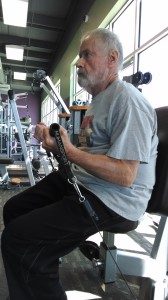Although people engage in fitness and sports activities for various reasons, the fact remains that they are inherently physical activities.
So whether you exercise for stress reduction, weight loss, or sport, it makes sense to train in a manner which is consistent with accepted training principles and methodologies. Doing so will make the outcome of training less haphazard and more predictable. It will also enhance the appreciation of movement one should derive from any form of physical activity.
As all coaches know, mastery of a sport is accomplished by developing a foundation before progressing to more advanced levels of training. As accepted as this principle is, many people possess only a vague understanding of what this means in concrete terms. The purpose of this article is to expose the reader to foundational training concepts derived from the world of sports science. And while you might not be a competitive athlete, I believe you can benefit greatly from recent developments in sport science.
One such development comes from Dr. Tudor Bompa, former Romanian rowing coach and currently a professor at York University in Toronto, Canada.
Bompa has developed a useful schema called “The Training Factors Pyramid,”* which can be used to develop long term training plans, based on a foundational progression of factors over time.
The Training Factors Pyramid helps to identify a logical sequence of training factors, and can be used by athletes and fitness enthusiasts alike to identify objectives and evaluate training programs and methods. When problems develop, as they inevitably do, The Training Factors Pyramid can be used to determine what level these problems originate from, which speeds up the corrective process considerably.
The pyramid consists of four ascending levels. The athlete enters the pyramid at the first level—physical preparation. This level is the cornerstone of an athlete’s training, because without it, further progress is impossible. Physical preparation refers to the development of what sports scientists call “biomotor abilities”— strength, power, speed, balance, flexibility, agility, endurance, and coordination.
The second level of the pyramid involves technical preparation— or perfecting physical techniques. While some techniques can be mastered with a low level of physical preparation, many cannot. Many currently popular recreational sporting activities, such as in-line skating and rock climbing, to name two, require a fairly high level of physical development before many skills can be practiced.
Of course, technical mastery is not the final objective, for any athlete. We all know of athletes who have beautiful and “correct” techniques, but who lack the ability to apply them in a sport setting.
This brings us to the third level of The Training Factors Pyramid: tactical preparation. Tactics simply refer to the ability to successfully apply techniques in a sport situation. It should be obvious to the reader at this point that technically sound technique must be established before entering level three. Further, the athlete must have a high level of physical development before correct technique is possible.
The fourth and final stage is called psychological preparation—a very important consideration for athletes who hope to compete successfully. But clearly, psychological preparedness— let’s just call it confidence— cannot be established if the athlete has not successfully ascended through the previous three levels.
How can The Training Factors Pyramid be used in an everyday, practical setting? Let’s suppose you’re a serious recreational beach volleyball player, and you’re having problems with your spike. The first step is to determine whether or not you can execute a technically correct spike in an isolated situation (i.e., in practice).
If the answer is no, then we go down a level and try to find faults your physical preparation— perhaps you lacks adequate explosive strength to clear the net. Once your physical attributes are improved, you should be more successful in delivering the spike in competitive situations.
If the answer is yes (you can deliver a proper spike), the problem lies in either tactical or psychological development. Both areas are closely intertwined— a lack of tactical skill can obviously impair confidence. And vice versa. Athletes commonly progress well through physical and technical training, but falter in tactical/psychological realms. The solution is more time in the trenches, with careful progression through gradually more difficult encounters. When tactical successes begin to outweigh the failures, confidence increases along with tactical ability.
Although the four training factors have been isolated for the sake of discussion, in reality, they must be integrated if a successful outcome is desired.
For example, is a serve a technique or a tactic? At novice levels of play, it is primarily technical, but at high levels of skill, techniques and tactics are one and the same. Also worth noting is the fact that the direction of influence is not only ascending, but descending as well. For example, the techniques you’ll use affect the physical preparation you’ll need to do.
Aside from day to day considerations, The Training Factors Pyramid should also form a template for long term planning, as well.
Accordingly, the first several months of training should be dedicated to improving physical attributes, although simple technical and tactical skills may be presented as well. The second phase of training is characterized by developing technical mastery of your sport skills. Physical condition must be maintained, but this involves less work than it took to develop it. Advanced stages of training target tactical and psychological concerns, with comparatively less time spent on physical and technical development.
While achieving mastery in sport involves years of hard work, those years yield far more result when they are spent wisely. The time you spend developing your foundation is miniscule compared to the time it takes to correct long-entrenched errors from years of poorly-conceived and executed training.






Hi Charles,
Interesting post.
(I was familiar with Bompa’s work on periodization, but didn’t know about this.)
I can see how an intermediate or advanced athlete might use “The Training Factors Pyramid,” but for beginners (and most people) I’d focus on the basics: proper eating, proper training, and proper recovery.
Useful to spot where’s the flaw in an athlete’s preparation, though (like you outlined).
Best,
-Carl Juneau
This article rings true. I know with tennis, physical conditioning was primal to advancing skills and precision performance. I would break down a set of movements and concentrate on pieces of that movement, say a good topspin stroke or an overhead smash.
Immersion as I call it, is where you give your body, the muscle memory control, as much repeated exposure as possible so that it can become sensitized to what the feelings and sensations are that produce the correct desired results. Good article.